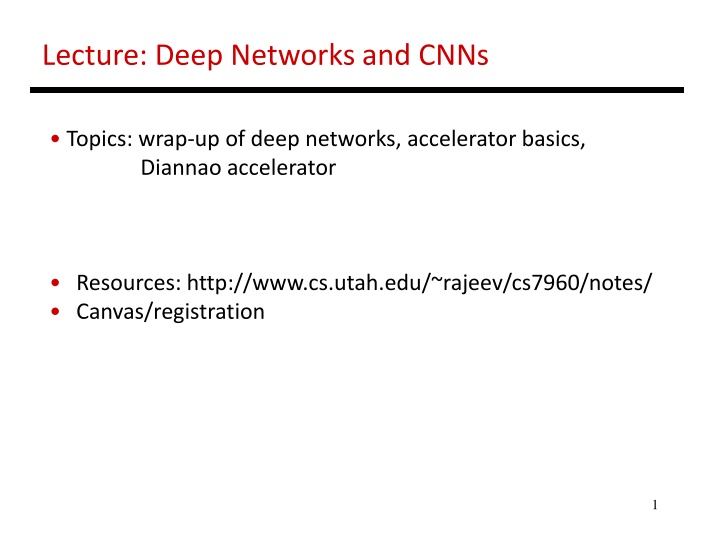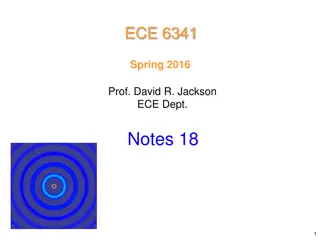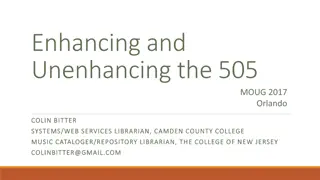
Deep Networks and CNNs: Image Classification Benchmarks
Explore the evolution of deep networks for image classification, focusing on benchmarks like MNIST and ILSVRC. Discover the success stories of deep learning surpassing human performance in tasks like MNIST (>99%) and ILSVRC top-5 (>95%).
Download Presentation

Please find below an Image/Link to download the presentation.
The content on the website is provided AS IS for your information and personal use only. It may not be sold, licensed, or shared on other websites without obtaining consent from the author. If you encounter any issues during the download, it is possible that the publisher has removed the file from their server.
You are allowed to download the files provided on this website for personal or commercial use, subject to the condition that they are used lawfully. All files are the property of their respective owners.
The content on the website is provided AS IS for your information and personal use only. It may not be sold, licensed, or shared on other websites without obtaining consent from the author.
E N D
Presentation Transcript
Lecture: Deep Networks and CNNs Topics: wrap-up of deep networks, accelerator basics, Diannao accelerator Resources: http://www.cs.utah.edu/~rajeev/cs7960/notes/ Canvas/registration 1
Deep Networks for Image Classification MNIST: 784-pixel images of hand-written digits; 50K training images; 10K testing images We will primarily focus on image classification because it is one of the success stories for deep learning. Let s start by examining the workloads used to evaluate deep learning. The most commonly used benchmark is the MNIST dataset. It has been over-used to the point that it is starting to lose relevance as a research platform. Each image in this dataset is a 28x28 (784 pixels) image of a hand-written digit. 50K images are used for training and 10K images are used for testing. 2
Deep Networks for Image Classification ILSVRC: e.g., 1000 categories, 1.2 million training images, 150K test images, top-5 criterion A second commonly used benchmark set is ImageNet, which consists of over 16 million images (examples above) with objects in 20K different categories. A subset of these are used for the annual ILSVRC competition, e.g., in some years, they have used 1.2 million images for training and 150K images for testing. These images only have objects in 1000 categories. Some of these images may have multiple objects, e.g., a dog chasing a ball, but the image label says dog . To deal with such situations, the competition defines a top-5 criterion that allows the network to make 5 best guesses if one of these matches the label, the prediction is deemed accurate. Clearly, the top-1 criterion is also a relevant metric. Recently, even this simplified subset has been conquered , with deep networks achieving near-human accuracy (top-5 rate of 95%, top-1 rate of close to 80%). Of course, these are relatively easy problems, so much work remains in designing better deep networks. 3
Deep Networks for Image Classification MNIST: 784-pixel images of hand-written digits; 50K training images; 10K testing images ILSVRC: e.g., 1000 categories, 1.2 million training images, 150K test images, top-5 criterion 4
Deep Learning Success Modern deep learning is better than humans on both MNIST (>99%) and ILSVRC top-5 (>95%) This is an example of MNIST images that a simple deep network was not able to correctly predict. The image label is on the top-right and the network prediction is on the bottom-right. You ll see that for the most part, these are examples of poor hand-writing, not poor network behavior. 5
This slide shows how we can begin with a shallow network and keep adding layers to get higher accuracies on MNIST. The final network has two convolutional/pooling layers, two fully-connected layers, and a bunch of tricks to prevent over-fitting and manage the weights. Accuracies Baseline: single hidden layer with 100 neurons: 97.8% CNN: added 20 5x5 filters and a 2x2 max-pool: 98.78% CNN: added 40 20x5x5 filters and 2x2 max-pool: 99.06% CNN: substitute sigmoid with ReLU: 99.23% CNN: expand the training data: 99.37% CNN: adding two fully-connected layers: 99.43% CNN: 1000 neurons in fully-connected layers: 99.47% CNN: adding dropout: 99.60% CNN: voting among an ensemble of 5 nets: 99.67% (ILSVRC winners have 152 layers) Many ways to avoid over-fitting in fully-connected networks (conv layers don t need these because the weights are shared): L2 regularization, dropout, expanded inputs. 6
These tricks include using a better activation function (ReLU), converting each training image into 5 training images (by shifting each image to the top/left/right/bottom by 1 pixel), dropout (randomly eliminating some activations during training), L2 regularization (including the weights in the cost function so the weights don t grow too large), etc. Accuracies Baseline: single hidden layer with 100 neurons: 97.8% CNN: added 20 5x5 filters and a 2x2 max-pool: 98.78% CNN: added 40 20x5x5 filters and 2x2 max-pool: 99.06% CNN: substitute sigmoid with ReLU: 99.23% CNN: expand the training data: 99.37% CNN: adding two fully-connected layers: 99.43% CNN: 1000 neurons in fully-connected layers: 99.47% CNN: adding dropout: 99.60% CNN: voting among an ensemble of 5 nets: 99.67% (ILSVRC winners have 152 layers) Many ways to avoid over-fitting in fully-connected networks (conv layers don t need these because the weights are shared): L2 regularization, dropout, expanded inputs. 7
Glossary Sigmoid activation function: f(x) = 1/(1+e-x) provides a smooth step function; tanh is similar. ReLU activation function: f(x) = max (0,x) it allows the output to grow larger than 1, and has a larger of 0 or 1. Softmax activation function: f(zj) = ezj/ kezk -- it s normalizing the neuron outputs in a layer so they sum to 1 and the largest neuron sticks out Feature map and filter: a filter or kernel is the grid of weights; a feature map is the resulting set of values when a filter is applied to a set of inputs Max pooling: extracts the largest value in a 2D input grid L2 pooling: computes the square root of the sum of squares of the values in a 2D input grid L2 regularization: includes the weights in the cost function during training so we re trying to not only reduce the error, but also the values of the weights Expanded inputs: to avoid over-fitting, the (say) 50K training images are expanded to 250K images. Each image is shifted slightly to the left/right/top/bottom. Dropout: some activation functions are randomly dropped during training (to avoid overfitting). DNN/CNN: CNNs use shared kernels for all neurons in a feature map, while DNNs use private kernels for each neuron in a feature map. SVM: a mathematical approach to incrementally define hyperplanes that separate clusters an alternative way to classify inputs into different categories. 8
LSTMs The neurons in MLPs and CNNs do not have state every input image results in brand new computations with no memory of previous images. An LSTM is better suited for speech/text processing where interpreting a new syllable or pronoun may depend on past inputs. Recurrent neural networks (RNNs, where a layer s output feeds back as input for the next computation) have evolved into LSTMs 9
LSTMs 4. Convert cell states to (-1, 1) 5. What part of the cell must be output 2. New info to be retained 1. Forget gate 3. Strength of new info 10 Image credit: http://colah.github.io/posts/2015-08-Understanding-LSTMs/
Accelerator Basics Software optimizations: loop ordering, tiling Hardware techniques: prefetching, SIMD units, near- data processing, The last lecture discussed recent progress in deep learning algorithms. These algorithms (inference and training) consume large amounts of time and energy on modern systems. Custom accelerator hardware will clearly help. We ll start by first examining a few software optimizations, followed by accelerators that rely on digital units. 11
Loop Nesting Do all images Do all output feature maps Do all input feature maps Do all horizontal pixels in output fmap Do all vertical pixels in output fmap Do all horizontal pixels in kernel Do all vertical pixels in kernel 12 Source: SCNN: An Accelerator for Compressed-Sparse Convolutional Neural Networks, A. Parashar et al., ISCA 2017
Data Access Pattern Classifier Layer Let s first understand tiling in general terms. Consider the vector matrix multiplication that is required in the fully-connected classifier layer. The inputs come from the left (green) and each column computes a dot-product for its neuron (violet). As shown on the right, the columns of the synaptic weight matrix are accessed one column at a time. If we assume that the matrices are large and that even a single row or column is too large to fit in cache, the input vector keeps entering the cache and keeps getting evicted out of the cache. So, even though the input vector has reuse, it is not exploiting the cache. The synaptic weights have no reuse; they have to be fetched entirely from memory, used once, and then thrown away. Similarly, the neurons have no reuse. They are written exactly once. 13
Tiling to Reduce Data Fetches So all we can do is re-organize the access pattern so that the input vector reuse can exploit the cache. We break the input vector into a small tile that fits in cache (light green, shown on the right) and multiply it with a subset of the first column. This produces a partial result for the first neuron. Next, we apply that small tile to a subset of the second column. And we repeat this for all the columns. Then, we carve out the next small tile of the input vector and apply it to subsets of all the columns. Each small tile creates an increment for the neuron. So the neuron is now written multiple times (instead of once as before). But the input vector is only fetched once from memory. Depending on the sizes of the row, column, tile, and cache, this may be a worth-while trade-off. As before, the synaptic weights are fetched exactly once. 14
Tiling Example Cache size of 256 4096 inputs 1024 neurons 15
Tiling Example Cache size of 256 Baseline: Total fetch = 4M (i) + 1K (n) + 4M (s) Tile 256 inputs: Must fetch 1024 x 4096/256 neurons Total fetch = 4K (i) + 16K (n) + 4M (s) 4096 inputs Tile 128 inputs and 128 neurons: Total fetch = 32K (i) + 1K (n) + 4M (s) 1024 neurons As we can see from this example, tiling can reduce the bandwidth requirement of the classifier layer by ~2X. You could try more tiling tricks (e.g., see the last row above), but at this point, the weight matrix is the bottleneck and this cannot be fixed. The only way to improve reuse of the weight matrix is to fetch multiple images (batching) and process them all in parallel, essentially converting our vector- matrix multiplication into a matrix-matrix multiplication. That is, fetch a tile of weights and use it N times to process N different input images.
Access Pattern Convolution Layer Now let s consider the convolution layer. Note that the 3D kernel below turns out to just be an over- sized version of the 2D kernel example. For simplicity, let s just look at the 2D kernel example. The kernel is relatively small and let s say it fits in cache (if it does not, then tiling the kernel will help too). The output image (the large yellow block on the right) is written exactly once. The green input image pixels do exhibit reuse. If we assume a 5x5 kernel that keeps shifting by one unit, an input pixel is involved in 25 different convolutions. 20 of those will be cache hits because once fetched, a pixel is involved in 5 consecutive convolutions. But every input pixel is fetched 5 times from memory, which is expensive.
Tiling Convolution Layer To reduce this overhead, we ll tile the input image. The blue tile on the left is large enough to fit in cache. Once that tile has been brought in, we ll apply convolutions to maximize reuse of that tile. In the example here, we bring in an 8x8 input image tile so it fits in the 64 entry cache. We then apply the 2x2 kernel 49 times within this tile before moving on to the next tile. So we fetch 64 input pixels to process 49 convolutions. We are fetching 3969 x 64/49 input pixels and writing 3969 neuron values. In the baseline, each of the 4K inputs is fetched twice. So tiling does help reduce convolution bandwidth requirements. 2x2 kernel 4096 inputs 3969 neurons Cache size = 64 What is the tile size? Data fetched? 18
Tiling Convolution Layer 2x2 kernel 4096 inputs 3969 neurons Cache size = 64 What is the tile size? 8x8 Data fetched? Baseline = 8K (i) + 4K (n) Tiling = 4K x 64/49 (i) + 4K (n) 19
Its all about memory management! DianNao uses tiling to reduce memory bandwidth needs. Beyond this, DianNao does little to alleviate the memory bottleneck. The follow-up architecture, DaDianNao does a much better job addressing the memory bottleneck. DianNao Intro Deep learning: many layers, large amounts of data moving between layers, many synaptic weights Most prior work did little to address the high cost of bringing data to/from memory DianNao uses tiling, buffering, prefetching to reduce these costs DaDianNao does even better Focus only on inference for now Programmable, so it can adapt to algorithm tweaks 20
Spatially Unfolded Design Implement the full neural network with dedicated latches, multipliers, adders, and sigmoid units Reasonable for small networks, e.g., 90-10-10 network can be implemented with 974x lower energy than a general-purpose core One way to implement a neural network is to have dedicated logic for every neuron. In this figure, we see a register for every weight. The weight and the input are fed to a multiplier. An adder sums up the outputs of the multipliers. That result then goes to a look-up table that implements the activation function (more on this later). The activation result then feeds the multipliers of the next neuron layer. 21
Spatially Unfolded Design Implement the full neural network with dedicated latches, multipliers, adders, and sigmoid units Reasonable for small networks, e.g., 90-10-10 network can be implemented with 974x lower energy than a general-purpose core This is a very expensive way to implement a neural network. The graph on the next slide shows how the implementation overheads increase more than linearly with the number of neurons. Even implementing a small 90- 10-10 network will take up most of the chip area. But they do consume significantly lower energy than a general- purpose core. 22
Scalability Spatially unfolded approach does not scale well 23
DianNao Approach Place data in memory and prefetch tiles into buffers Each data type has a different requirement, so implement multiple buffers The ALUs must be time-multiplexed across several neurons DianNao uses a folded approach, where a few hardware units are used by several neurons in a time-multiplexed manner. Since the bottleneck is the access of large sets of inputs/weights/outputs, DianNao uses a set of buffers to bring in the required elements. Tiling is used to maximize reuse of the data that is brought into these buffers. There are separate buffers for inputs, weights, and outputs since each has a different access pattern. DianNao implements a single Neural Functional Unit (NFU) shown on the next slides. The NFU has the three buffers mentioned above (purple), the computational unit (light blue), and control units (yellow). The NFU is set up to handle 16 neurons in parallel. Each of these neurons can handle 16 inputs at a time. If a neuron has more than 16 inputs, its result is computed over many cycles and partial sums are aggregated. 24
Reasoning about Performance, Power The computational unit has 256 parallel multipliers (to handle 16 inputs for 16 neurons). This is followed by 16 adder-trees, one per neuron. Each tree has 15 adders to aggregate the results of 16 multipliers. The sum-of-products is re-used in the next cycle if we have more inputs to aggregate. If we re done, the sum-of-products is sent to the activation function. The activation function is implemented with piecewise linear interpolation, i.e., the non-linear function is split into 16 linear segments. A look-up table tracks the end-points of each segment and allows us to quickly apply any user-defined activation function. These units are implemented as an 8-stage pipeline. The NBin buffer supplies the 16 neuron inputs. The SB buffer supplies the 256 synaptic weights. The NBout buffer receives the 16 neuron outputs. This also specifies the width/wiring for each buffer. The Control Unit spits out instructions to advance the computations in every cycle. The authors use tiling and prefetching to hide the memory bottleneck, but I don t believe that s actually happening. It may help in the convolutional layers, where a tile is brought into NBin and then reused several times. Although, note that for every reuse, the inputs to the multipliers have to be shuffled around the authors address that in a later paper. But tiling and prefetching provide no help for the final classifier layers where the weights are never re-used and 256 new weights have to be provided every cycle. Fetching these 256 weights every cycle is a critical bottleneck and will overwhelm the memory system. This requires 512 B/cycle, roughly 512 GB/s. A modern DDR3/DDR4 memory channel provides only ~16GB/s. So we would need 32 memory channels to feed the SB (today s best processors only have a handful of memory channels)! 25
DianNao What this means is that the memory system is the clear bottleneck for the classifier layer and designing a fancy accelerator has zero impact. Even the convolution layer needs 2-3 memory channels worth of bandwidth. This is why I said that DianNao is not a significant contribution (although, they do deserve great credit for identifying a very important problem and putting forth the first solution) DaDianNao does a much better job addressing the real bottleneck. Similarly, the impact on power is also low because most of the power is in memory accesses and we re doing little to address the power for weight accesses (Amdahl s Law). 26
DianNao 27
Design Summary Different bit widths for each buffer (Tn = 16, 64 entries) Separate scratchpads avoid tags/unpredictability/conflicts, and improve latency, parallelism 256 parallel multiplies (16 neurons, each with 16 inputs) 16 parallel accumulates (each is a tree with 15 adders) Partial sums if necessary Sigmoid (or any function) is implemented with piecewise linear interpolation 16 hard-wired segments and coefficients can be programmed into a small table Control processor has a number of instructions that specify how data is loaded/accessed in buffers Memory bandwidth/energy bottleneck and Amdahl s Law 28
Fixed Point Arithmetic DianNao uses 16b fixed-point arithmetic; much more efficient than 32b floating-point arithmetic, and little impact on accuracy Many studies have shown that neural networks can tolerate low precision in the weights and inputs. This study shows that you can reduce area/power by ~7x if you went from 32b floating-point math to 16b fixed-point math. The graph on the next slide shows that the impact on accuracy is also small (at least for small-scale workloads). As a reminder, fixed-point represents each number as an integer (or perhaps with a binary point in some fixed position, but that has no impact on the arithmetic) and there is an implied scaling factor. 29
Precision Analysis for DNNs Min bits required per layer for accuracy within 1% Source: Proteus, Judd et al., WAPCO 16 31
Implementation Details/Results Cycle time of 1.02ns, area of 3mm2, 485mW power The NFU is composed of 8 pipeline stages Peak activity is nearly 500 GOP/s 44KB of RAM capacity Buffers are about 60% of area/power, while NFU is ~30% Energy is 21x better than a SIMD baseline; this is limited because of the high cost of memory accesses Big performance boosts as well: higher computational density, tiling, prefetching 32
Benchmarks 33
DianNao Conclusions Tiling to reduce memory traffic Efficient NFU and buffers to reduce energy/op and prefetch Even with these innovations, memory is the bottleneck, especially in a small accelerator with few pins For example, each classifier layer step needs 256 new synaptic weights (512 bytes), while 4 memory channels can only bring in 64 bytes per cycle Energy consumed by the DianNao pipeline per cycle = 500pJ Energy per cycle for fetching 64 bytes from memory = 35nJ (70 pJ/b for DDR3 at 100% utilization, Malladi et al., ISCA 12) It s all about the memory bandwidth/energy !!! 34
The GPU Option Modest (but adequate) memory capacities (a few giga-bytes) High memory bandwidth, e.g., 208 GB/s (NVIDIA K20M) But, high compute-to-cache ratio on the chip Therefore, average GPU power of ~75 W, plus expensive memory accesses GPU card TDP of ~225W A GPU out-performs DianNao by ~2X GPUs are the current platforms for machine learning. They are great in terms of memory bandwidth and in their SIMD-ness. This also means high power (GPUs are still general-purpose , so more customization will help). DianNao is 2x slower, but the DianNao paper is not clear about memory bandwidth assumptions (we know that is key to this comparison). 35
References DianNao: A Small-Footprint High-Throughput Accelerator for Ubiquitous Machine Learning , T. Chen et al., Proceedings of ASPLOS, 2014 36






















